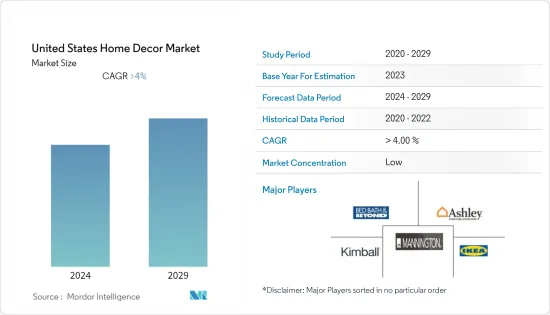PUBLISHER: Mordor Intelligence | PRODUCT CODE: 1519921

PUBLISHER: Mordor Intelligence | PRODUCT CODE: 1519921
United States Home Decor - Market Share Analysis, Industry Trends & Statistics, Growth Forecasts (2024 - 2029)
The United States Home Decor Market size is estimated at USD 206.70 billion in 2024, and is expected to reach USD 252.82 billion by 2029, growing at a CAGR of 4.11% during the forecast period (2024-2029).

The US home decor market has witnessed a consistent growth trajectory, and this upward trend is poised to persist. A surge in consumer demand for home decor essentials like furnishings, textiles, and floor coverings primarily drives this growth in the market. Additionally, the rising popularity of compact housing has spurred a demand for products with enhanced storage options, elevating the aesthetic appeal of homes.
Conversely, the market is witnessing a surge in demand for bespoke and trendy home decor products, particularly among affluent consumers. These factors are paving the way for a promising growth outlook in the United States home decor sector.
With a commanding share of over 60% in North America, the United States home decor market is outpacing its regional counterparts, propelled by evolving lifestyles and a surge in household possessions. As homeownership rises, the utilization of furniture, textiles, and floor coverings as design elements to enhance living spaces is gaining traction.
The advent of e-commerce, coupled with the widespread adoption of smart devices like mobiles and tablets, has bolstered the preference for online purchases in the home decor segment. This shift toward digital channels, offering seamless payment and delivery options, is poised to be a defining trend in the global home decor market in the coming years.
United States Home Decor Market Trends
The Market is Being Fueled by the Growth of E-Commerce Distribution
Online shopping platforms have revolutionized the accessibility of home decor, offering customers an extensive range of options at their fingertips. Retailers are enhancing the buying experience by providing virtual room planners, detailed product descriptions, and user feedback. The convenience of home delivery and often more competitive pricing have further fueled the popularity of home decor items among consumers.
Online shopping has increased, driven by the ubiquity of smart devices, a buoyant economy, and the evolution of m-commerce's purchase and delivery options. The online home decor market is on an upward trajectory, buoyed by factors such as free delivery, robust customer support, secure online payment systems, and user-friendly website designs. A notable catalyst for this growth is the upswing in online sales, amplified by the proliferation of new smartphones and expanding avenues for mobile commerce.
The Real Estate Sector's Growth Fueled the Consumer's Interest in Home Decor Products.
The real estate market's robust growth is fueling a parallel surge in demand for home decoration services. This surge is mirrored in the expanding home decor market. Notably, the interior design sector has evolved to cater to the rising demand for high-end luxury home decor, enhancing the guest experience. A notable driver of the home decoration industry's growth is the rising trend of house renovations, which is broadening the array of interior design offerings, ranging from marble or wood flooring to decorative lighting and eco-friendly furniture.
The rapid expansion of the real estate sector is amplifying the need for services like interior design and home decor. This, in turn, is propelling the home decor market, with a particular uptick in demand for items like furniture, home textiles, and flooring. As a result, the home decor market is poised for gradual growth in the coming years.
United States Home Decor Industry Overview
The US home decor market is fragmented. Its growth is propelled by a thriving real estate sector. Currently, a handful of key players dominate the market. Yet, fueled by technological advancements and innovative offerings, smaller and mid-sized firms are bolstering their market presence. They are achieving this by securing fresh contracts and venturing into untapped markets. Some of the market leaders include Inter IKEA Systems BV, Bed Bath & Beyond Inc., Ashley Furniture Industries, Inc., Mannington Mills Inc., and Kimball International Inc.
Additional Benefits:
- The market estimate (ME) sheet in Excel format
- 3 months of analyst support
TABLE OF CONTENTS
1 INTRODUCTION
- 1.1 Study Assumptions & Market Definition
- 1.2 Scope of the Study
2 RESEARCH METHODOLOGY
3 EXECUTIVE SUMMARY
4 MARKET DYNAMICS
- 4.1 Market Drivers
- 4.1.1 The Demand for Home Decor Products is Surging as People are Inclined to Show their Creativity Through DIY Activities.
- 4.2 Market Restraints
- 4.2.1 The Price Fluctuations of Raw Materials can be a Challenge for the Home Decor Industry.
- 4.2.2 Lack of Skilled Labour who Design Home Decor Furniture
- 4.3 Market Opportunities
- 4.3.1 Growing Significance of Social Media and Celebrity Partnerships
- 4.3.2 Trends in the Adoption of Environmentally Friendly Products
- 4.4 Industry Attractiveness - Porter's Five Forces Analysis
- 4.4.1 Threat of New Entrants
- 4.4.2 Bargaining Power of Buyers/Consumers
- 4.4.3 Bargaining Power of Suppliers
- 4.4.4 Threat of Substitute Products
- 4.4.5 Intensity of Competitive Rivalry
- 4.5 Impact of COVID-19 on the Market
- 4.6 Insights into Technological Advancements in the Duty Free and Travel Retail
5 MARKET SEGMENTATION
- 5.1 By Product
- 5.1.1 Home Furniture
- 5.1.2 Home Textiles
- 5.1.3 Flooring
- 5.1.4 Wall Decor
- 5.1.5 Lighting and Lamps
- 5.1.6 Acessoriess
- 5.1.7 Other Home Decor Products
- 5.2 By Distribution Channel
- 5.2.1 Supermarkets/Hypermarkets
- 5.2.2 Specialty Stores
- 5.2.3 Online
- 5.2.4 Other Distribution Channels
6 COMPETITIVE LANDSCAPE
- 6.1 Market Concentration Overview
- 6.2 Company Profiles
- 6.2.1 Ashley Furniture
- 6.2.2 Ikea USA
- 6.2.3 American Textile Systems
- 6.2.4 Acuity Brands Lighting
- 6.2.5 Generation Lighting
- 6.2.6 Mohawak Flooring
- 6.2.7 Shaw Industries Group
- 6.2.8 Mannington Mills Inc.
- 6.2.9 Kimball International
- 6.2.10 Herman Miller Inc.
- 6.2.11 Crane & Canopy Inc*
7 FUTURE MARKET TRENDS
8 DISCLAIMER




